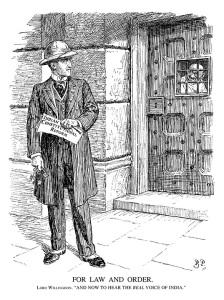
A cartoon depicting Willingdon and Gandhi
At the end of his term in 1936, Lord Willingdon, the departing Viceroy of India, could look back in satisfaction. Five years ago, when he had arrived, the country was in disarray. In the throes of the Great Depression, discontent amongst the public was widespread. Congress’s Civil Disobedience campaign was proving to be successful, having paralyzed the British administration. Worse, Willingdon’s predecessor, Lord Irwin, had tried to buy off the movement by negotiating one-on-one with Mahatma Gandhi, leading to the famous Gandhi-Irwin Pact. In Willingdon’s book, this was a grave mistake, which elevated Congress to a level equivalent to the British government.
During his tenure, Willingdon tried to put things back on track. He crushed the Civil Disobedience campaign, rounding up thousands of Congressmen and outlawing most of Congress organizations. By 1933, the campaign had to be suspended due to lack of enthusiasm. Willingdon never granted Gandhi a one-on-one audience and insisted that Congress was just one of many political voices in India. Over Congress’ vehement protests, he introduced a new constitution to govern India in 1935. All in all, by the time of his departure, things were looking up. Congress seemed to be in disarray and British officials felt confident that the party will soon split because of the infighting between the Gandhians and the Socialists. The upcoming elections of 1937, in which they expected Congress to perform poorly, would prove for once and for all that the party could not claim to speak for the entire country. Willingdon could have scarcely believed that only months after his departure, Congress would emerge united and stronger than ever before. And it would do this by using the instrument he had left behind – the 1937 elections. Continue reading

